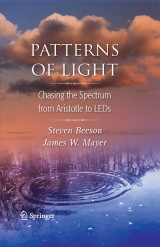Details

Patterns of Light
Chasing the Spectrum from Aristotle to LEDs|
181,89 € |
|
| Verlag: | Springer |
| Format: | |
| Veröffentl.: | 23.10.2007 |
| ISBN/EAN: | 9780387751078 |
| Sprache: | englisch |
| Anzahl Seiten: | 196 |
Dieses eBook enthält ein Wasserzeichen.
Beschreibungen
Light is all around us. Vision is our dominant sense, and we are richly rewarded with a palette of colors from red to violet. Our eyes do not detect the l- energy, long-wavelength infrared (IR) radiation, but we know it exists from d- cussions of war applications and televised images of guided weapons targets. Our eyes do not detect the higher-energy (above visible light energies) and shorter-than-visible-wavelength ultraviolet radiation, and yet we know it is there from the sunburn we receive in Arizona. We also know that window glass can block ultraviolet rays so we don’t get a burn while driving with the windows rolled up. We know about radio waves from the little boxes that talk to us and x-rays from the dentist office. These waves and rays belong to the same family of light, often called photons (from the Greek photos, light), that describes the spectra of electromagnetic radiation over 10 orders of magnitude from very low-energy - dio waves to very high-energy x-rays and gamma rays.
Introduction.- The Path of Light: Light beams, Light paths, Pinholes.- Reflection of Light: Mirrors, Daguerreotypes, Equal angles, Windows.- Refraction of Light: Speed of light, Waves, Refractive Index, Total internal reflection, Mirages.- Lenses: Focal length, Magnification, Photography, Fresnel lenses.- Color: Color and Light, The Eye and Color Sensation, Sources of Light, Composition of Light.- Rainbows: Your own rainbow, Secondary rainbows, Light inside, Double rainbows.- Blue skies and White clouds: Scattering, Rock candy/glass, Salt/sugar/foam, Water/ice.- Interference & Color: Soap bubbles, Oil/gas on water, Feathers.- Polarized light: Sunglasses, Blue sky.- The photon: a. Photoelectric effect, Solar panels, CCDs, LEDs.- Optical Spectroscopy: a. Light and electrons, Optical light emission, Prisms/gratings, Neon lights.- Electrons in atoms: Photons and electrons, X-rays, Optical absorption.- IR-UV-X-rays: Paintings in IR/UV/X-ray, Scorpions in UV, Suntans, Teeth in X-ray.- Optical and electron microscopy: Depth of focus, Images of Nature, Simple microscopes, Compound microscopes, SEM.- Mars.
<P>Light is all around us – even when we do not see it. Our eyes do not detect the higher energy and shorter-than-visible-wavelength ultraviolet radiation, yet we know it is there from the sunburn we receive in Arizona. We know that window glass can block ultraviolet rays so we do not get a burn while driving with the windows rolled up. Our eyes do not detect the low-energy, long-wavelength infrared (IR) radiation but we know it exists from discussions of war applications and televised images of guided weapons targets. We also know about radio waves from the little boxes that talk to us and x-rays from the dentist's office.</P>
<P></P>
<P><EM>Patterns of Light</EM>, Chasing the Spectrum from Aristotle to LEDs, written by Steve Beeson and Jim Mayer starts with the visible – the straight path of light. It continues with chapters detailing reflection (mirrors, storefront windows) and refraction (eyeglasses, binoculars). Color is then introduced with the query "Why is the sky blue?" After answering that and other similar questions ("Why is snow white?"), the book goes beyond the visible to the infrared and ultraviolet. <EM>Patterns of Light’s</EM> many colorful photos and figures further aid in the reader’s grasp of the concepts discussed.</P>
<P></P>
<P><EM>Patterns of Light</EM> is a descriptive, rather than technical, book with the mathematics behind light included in the appendices. The book is designed for physics students of optics and engineering, but will certainly be enjoyed by all readers interested in gaining a broader perspective on light and its history.</P>
<P></P>
<P><EM>Patterns of Light</EM>, Chasing the Spectrum from Aristotle to LEDs, written by Steve Beeson and Jim Mayer starts with the visible – the straight path of light. It continues with chapters detailing reflection (mirrors, storefront windows) and refraction (eyeglasses, binoculars). Color is then introduced with the query "Why is the sky blue?" After answering that and other similar questions ("Why is snow white?"), the book goes beyond the visible to the infrared and ultraviolet. <EM>Patterns of Light’s</EM> many colorful photos and figures further aid in the reader’s grasp of the concepts discussed.</P>
<P></P>
<P><EM>Patterns of Light</EM> is a descriptive, rather than technical, book with the mathematics behind light included in the appendices. The book is designed for physics students of optics and engineering, but will certainly be enjoyed by all readers interested in gaining a broader perspective on light and its history.</P>
The book fills a void in the market by providing an overview of the entire electromagnetic spectrum, rather than just focusing on visible light Competing books are 20 years old; this book brings the topic up-to-date The book is observer-oriented with over 100 color photos as compared to decades-old texts which emphasize detailed treatments Includes supplementary material: sn.pub/extras
t/c with MS
Diese Produkte könnten Sie auch interessieren:

Femtosecond Optical Frequency Comb: Principle, Operation and Applications

von: Jun Ye, Steven T. Cundiff

149,79 €















